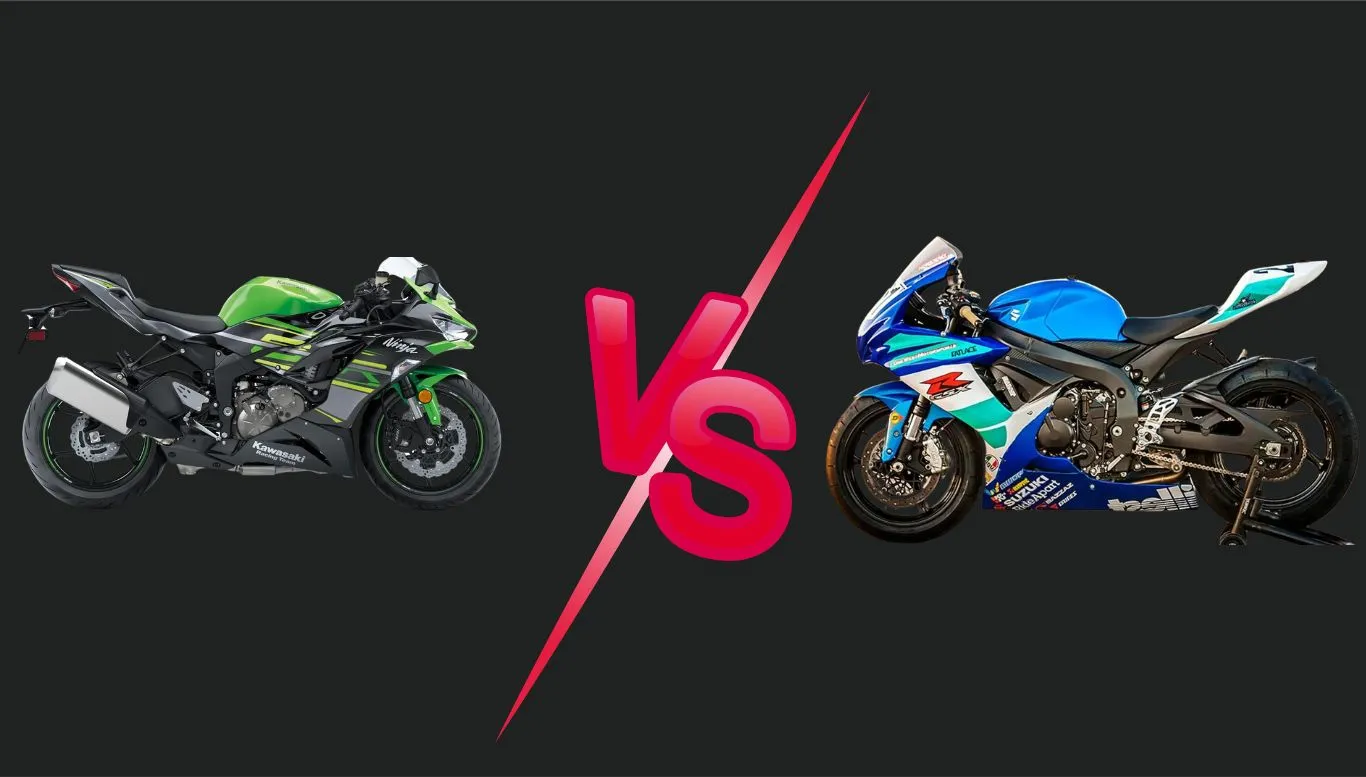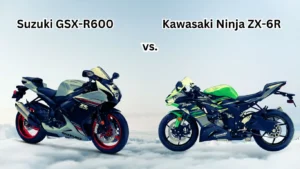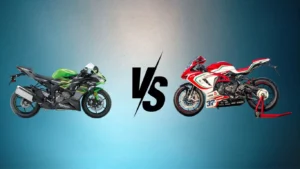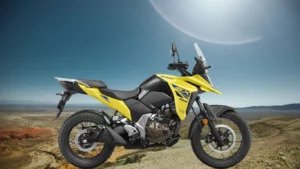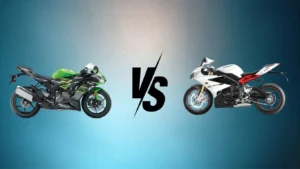If you have a need for speed and are deciding between a Kawasaki Ninja ZX-6R and a Suzuki GSX-R600, you’re in the right place. These two bikes are among the top choices in the motorcycling world, offering a combination of performance, features, and price that climbers, speed lovers, and general motorcycle enthusiasts can appreciate.
In this article, we delve into a comprehensive analysis, comparing these two giants of the bike industry. We will be assessing the performance stats, various features, and price tags to help you make an informed decision on which bike best suits your needs.
Exploring the Features: An In-Depth Review of the Suzuki GSX-R600
Let’s dive in and examine the Suzuki GSX-R600. This sport bike is prominent in the motorcycle arena and for good reasons; its features boast a blend of performance and style. By dissecting its aspects, you’ll gain a better understanding as to why it attracts riders from all walks of life. Here’s what you need to know:
Engine Performance
The Suzuki GSX-R600 comes with a 599cc, 4-cylinder engine that delivers impressive power and stability even at high speeds. The advanced engine design enhances throttle response and ensures smooth acceleration, offering a riveting ride every time.
Suspension and Braking
The GSX-R600 has a Showa BPF (Big Piston Front) fork and Brembo monobloc front brake calipers. These features translate into precise braking and outstanding handling on both city roads and race tracks.
Design and Ergonomics
Aligning with the trend of modern sportbikes, this model focuses on rider comfort. The ergonomic design, coupled with a lightweight frame, ensures effortless maneuverability. The aerodynamic build not only enhances aesthetics but also contributes to less wind resistance at higher speeds.
Electronics Package
The GSX-R600 is equipped with a comprehensive set of electronics, including Suzuki’s advanced Drive Mode Selector (S-DMS). It allows riders to adjust the power output from the engine, enabling a more customizable and enjoyable ride.
Budget Matters: Price Comparison Between Kawasaki Ninja ZX-6R and Suzuki GSX-R600
In the realm of motorcycles, the price point often plays a significant role in the final decision-making process, and the case isn’t any different when considering the Kawasaki Ninja ZX-6R and Suzuki GSX-R600. Determining which of these powerful machines offers more bang for your buck requires a detailed comparison, looking beyond just the upfront cost and delving into what each vehicle has to offer.
Initial Purchase Price
The most apparent factor to consider, of course, is the manufacturer’s suggested retail price (MSRP). Both the Kawasaki Ninja ZX-6R and the Suzuki GSX-R600 fall within a somewhat similar price range, though there may be slight variations based on the dealer and location. It’s vital to ensure you’re getting the features and performance you desire, keeping in mind that price doesn’t always equate to value.
Cost of Ownership
Another significant consideration should be the overall cost of ownership. This includes aspects like maintenance costs, accessories, aftermarket upgrades, insurance, and even fuel efficiency. While numbers may vary from instance to instance, comparing these aspects for both motorcycles will give you a clearer picture of the ongoing costs associated with each.
Value from Features
Lastly, it’s essential to weigh the value derived from the features each bike offers. A look at the respective electronics packages, engine performance, design features, safety mechanisms, all come into play. Do they justify the price you’re asked to pay? This evaluation will help determine which one offers more value for the price.
Resale Value
A bike’s ability to retain its value over time is another crucial factor, especially for individuals who may wish to upgrade or switch bikes later down the line. Some models are known for their excellent resale value, becoming a selling point in their favor. Examining each bike’s reputation in this context can make a difference when comparing costs.
Advanced Technology: Comparing the Tech Features of Suzuki GSX-R600 and Kawasaki Ninja ZX-6R
When it comes to advanced technology, both the Suzuki GSX-R600 and the Kawasaki Ninja ZX-6R don’t skimp. These two machines have been equipped with cutting-edge tech features to not only enhance performance but also to provide an unmatched riding experience. Let’s deep dive into these features and see how they compare on both bikes.
Instrumentation
The Suzuki GSX-R600 boasts a comprehensive instrument panel that includes speedometer, odometer, twin trip meters, clock, and engine temperature. The panel also indicates gear position, fuel consumption, and driving range, helping you to remain informed during your ride. On the other hand, the Ninja ZX-6R’s instrument panel keeps it simple yet informative, with essential details like speed, fuel level, engine temperature, and gear position, but lacks some of GSX-R600’s advanced features.
Electronic Rider Aids
Both bikes come equipped with different electronic rider aids to enhance rider control and safety. Kawasaki’s Ninja ZX-6R features Kawasaki Traction Control (KTRC), offering three modes for varying conditions. It also comes with an Integrated Riding Modes system, allowing riders to adjust power delivery and traction control. On the Suzuki GSX-R600, the performance aids are slightly more focused on track performance. It has a three-mode traction control system (S-DMS) that’s more uncompromising and also features Suzuki’s Drive Mode Selector.
Lighting
Lighting technology on both bikes enhances visibility and adds to the high-tech feel of the bikes. The GSX-R600 features vertically stacked headlights and LED running lights, making it highly visible. The ZX-6R is no slouch either, with dual LED headlights and taillights, creating a unique visual identity and improving visibility.
Fuel Efficiency: Which Bike Gives More Miles per Gallon?
When you’re riding the open road, maximizing your miles per gallon becomes a real gamechanger. Let’s put the Kawasaki Ninja ZX-6R and the Suzuki GSX-R600 head to head and see who takes the crown in fuel efficiency.
Fuel Consumption
The Kawasaki Ninja ZX-6R, recognized for its efficient fuel system, averages around 43 miles per gallon. On the other hand, the Suzuki GSX-R600, with its well-optimized fuel injection system, is known to deliver roughly 46 miles per gallon under comparable conditions. It essentially depends on your riding style, but in direct comparison, the Suzuki’s slightly higher average gives it the upper hand.
Fuel Tank Capacity
Delving into tank capacity, the Kawasaki Ninja ZX-6R features a 17-litre fuel tank as compared to the Suzuki GSX-R600, which holds right around 16.5 liters. Despite the slight advantage in tank size, the Kawasaki’s marginally higher consumption rates balance out the playing field.
Fuel Range
Given the combination of fuel consumption and tank capacity, the overall fuel range of these two bikes also becomes a significant factor. The range is crucial for long rides, dictating how often you’ll need to pull over for refills. Based on calculations, the Kawasaki will get you a range of around 730 kilometers on a full tank, whereas the Suzuki scores a slightly higher range, estimated around 760 kilometers.
In conclusion, even though the difference isn’t vast, the Suzuki GSX-R600 takes the lead in fuel efficiency, ensuring those extra miles that might make all difference in your riding experience.
Built to Last: Comparing the Durability and Reliability of ZX-6R and GSX-R600
In the world of motorbikes, resilience and dependability are paramount, forming the bedrock of rider confidence and faith in a chosen machine. Here, we’ll delve into the durability and reliability of the Kawasaki Ninja ZX-6R and Suzuki GSX-R600. These two titans of the road have earned their stripes on streets and circuits worldwide, and we’re going to dissect the nuances behind their reputations for enduring robustness and trustworthiness.
Safety First: Reviewing the Safety Features of Each Bike
When it comes to two-wheelers, ensuring your safety is a pivotal factor to consider. The Kawasaki Ninja ZX-6R and Suzuki GSX-R600 don’t just excel in performance but offer an impressive suite of safety features as well. Let’s delve into the details and analyze the safety attributes of each of these furious beasts.
ABS (Anti-lock Braking System)
Both the ZX-6R and GSX-R600 come with an anti-lock braking system (ABS) standard. This helps prevent the wheels from locking up during hard braking, offering better control and stability. Whether you’re riding under harsh weather conditions or on slippery roads, the ABS function plays a crucial role in grounding your bike and enhancing your safety.
Traction Control System
The Ninja ZX-6R features Kawasaki’s proprietary traction control system, known as KRTC (Kawasaki Traction Control), offering three different modes for various riding conditions. On the other hand, the Suzuki GSX-R600 is equipped with Suzuki’s advanced and sophisticated traction control system, aiding in maximizing your control over the bike under diverse conditions.
Disc Brakes
Disc brakes are yet another important security attribute incorporated in both these models. They boast dual disc brakes in their front and a single disc brake at the rear, offering you superior stopping power. This kind of braking facility equips you to react effectively and instantaneously in an emergency, ensuring your safety on the roads.
Rider Aids
Both motorcycles have invested in electronic rider aids to provide an extra layer of security. Rider aids include features like a quick-shifter for the Ninja ZX-6R and a low-RPM assist for the GSX-R600. These features play a significant role in making the ride less strenuous and more controlled, particularly for new or inexperienced riders.
In a nutshell, both the Kawasaki Ninja ZX-6R and Suzuki GSX-R600 have dedicated significant attention to rider’s safety, investing in a wide array of features and technologies to make your ride as smooth and secure as possible.
Customer Reviews: What Riders are Saying about ZX-6R and GSX-R600
Let’s dig into what the actual users, those who have ridden these beasts and tested them in various tracks and terrains, have to say. The viewpoints of the riders add a real-world perspective to our comparative study, helping us understand better how the Kawasaki Ninja ZX-6R and Suzuki GSX-R600 fare in terms of comfort, ride experience, and overall satisfaction.
Comfort Level
When it comes to comfort, an area where both the Kawasaki Ninja ZX-6R and Suzuki GSX-R600 are scrutinized is the seating arrangement. The ZX-6R tends to get high marks for its comfort-driven design, with riders frequently praising the plush seat and the natural riding position. The GSX-R600, while earning appreciation for its maneuverability, often receives mixed reviews for comfort with some riders finding the seating position a bit aggressive for long rides.
Ride Experience
Nothing speaks more about a bike’s performance than the ride experience. The experience of riding the ZX-6R is consistently described as exhilarating by users, who enjoy its smooth acceleration and superior handling. The GSX-R600 riders, on the other hand, hail its quick responsiveness and tremendous power output, particularly when pushed to higher RPMs.
Overall Satisfaction
The bottom line for many riders is the overall satisfaction and joy they derive from riding their chosen bike. For ZX-6R owners, the bike often scores high in terms of ride quality, build, and performance. The GSX-R600 riders, too, express a significant level of satisfaction, lauding its winning combination of speed, technology, and design.
Long Term Ownership
A key element that is often overlooked in reviews but should be taken into account is long-term ownership experience. The ZX-6R owners report positive experiences such as consistency in performance even after long-term use, the strength of parts, and minimal maintenance needs. GSX-R600 riders equally appreciate the bike’s durability and stability over the years, but some of them brought up slightly higher maintenance costs compared to the ZX-6R.
Resale Value: Which Bike Holds its Value Better?
Getting a serious deal from your motorcycle purchase isn’t only about the initial cost; it is equally, if not more critical to understand the long-term value proposition it offers. When considering buying either the Kawasaki Ninja ZX-6R or the Suzuki GSX-R600, it would help to ask: Which of these superb machines retain their value more effectively over time?
Depreciation Factors
There are several factors that can affect how much value a motorcycle retains over time. These include its brand reputation, model popularity, reliability, and availability of spare parts, among others. Both the Kawasaki Ninja ZX-6R and the Suzuki GSX-R600 are products of reputed brands with high model popularity. However, slight differences emerge when we evaluate their value retention in detail.
Brand Reputation and Popularity
Kawasaki and Suzuki, both being Japanese brands, are renowned for their reliability and durable build quality. They are further supported by a fervent fan following, which keeps demand high in the used market. This popularity often aids in slowing the rate of depreciation.
Maintenance and After Sales Support
Maintenance costs and availability of after-sales support are other factors that significantly affect resale value. While Kawasaki Ninja ZX-6R and Suzuki GSX-R600 have similar service intervals and maintenance costs, slight variations in after sales service and support can often influence resale values.
Final Depreciation Comparison
Looking at these factors in totality, it is challenging to declare an absolute winner in the game of depreciation between the two bikes. While one might edge out the other in certain respects, for the most part, both motorcycles maintain strong resale values when properly maintained. However, based on recent data, the Kawasaki Ninja ZX-6R tends to hold its value marginally better in comparison to the Suzuki GSX-R600.
The Final Verdict: Summarizing the Crucial Differences Between The Kawasaki Ninja ZX-6R and Suzuki GSX-R600
After our comprehensive analysis of the Kawasaki Ninja ZX-6R and Suzuki GSX-R600, it’s clear that both bikes offer impressive performance, features, efficiency, and safety measures. The decision between the two is likely dependent on your specific requirements and preferences. What may work as an advantage for one rider might not hold the same significance for another. That being said, let’s unpack some of the key differences that could help you make a well-informed decision.
Performance-Driven Features
Each bike has an appealing combination of power and agility. The Kawasaki Ninja ZX-6R shines with its impressive speed and quick throttle response, boasting a peppy 636cc engine. The Suzuki GSX-R600, on the other hand, offers a finely balanced ride experience with smooth, consistent power delivery thanks to its robust 599cc engine.
Budget Considerations
The Ninja ZX-6R tends to be slightly pricier than the GSX-R600. Still, considering the feature set, you may find that the higher initial purchase cost is justified. When considering cost of ownership, including maintenance and fuel consumption, the Suzuki GSX-R600 is arguably the more economical choice.
Technological Aspects
The Suzuki GSX-R600 showcases advanced technology with its intuitive instrument panel and rider aids, whereas the Kawasaki Ninja ZX-6R boasts cutting-edge additions like its traction control system. Both bikes feature effective lighting, contributing to their safety.
Durability and Reliability
Both bikes prove durable and reliable, ready to withstand the rigors of rigorous riding. However, your handling and maintenance practices will play a significant role in their longevity.
Safety Measures
Safety is a priority for both brands. Both bikes are equipped with ABS and a comprehensive set of rider aids such as traction control and disc brakes, ensuring a safer rider experience no matter the conditions.
Customer Satisfaction
Online reviews indicate high levels of satisfaction for both models. Ride experience, comfort levels, and general satisfaction scores are consistently high for both the Ninja ZX-6R and GSX-R600. A testament to their overall quality and performance.
Resale Value
Both bikes retain their value well, with slight advantages seen for the Kawasaki Ninja ZX-6R due to its popularity and more extensive feature set. Brand reputation and maintenance provisions also contribute to resale value.
Conclusion
In conclusion, choosing between the Kawasaki Ninja ZX-6R and the Suzuki GSX-R600 is not a straightforward task, as both bikes come with an impressive set of features, robust performance, and technological advancements. Your final choice would hinge notably on personal preferences regarding riding comfort, price, and brand loyalty.
Irrespective of your choice, what’s clear is that both bikes exemplify brilliant engineering and cater excellently to the needs of motorcycle enthusiasts. Whichever you choose, you can expect a high-octane, thrilling ride filled with speed, power, and remarkable handling experiences.
